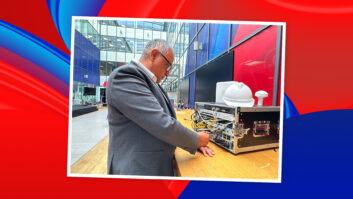
In an era marked by rapid technological advancement and escalating environmental concerns, the media and broadcast industry stands at a crucial juncture. Balancing innovation with ecological responsibility, a number of industry leaders are spearheading a movement towards sustainable practices, setting a new standard in environmental stewardship within the sector. From Formula 1’s monumental remote production operation at Biggin Hill to Riot Games’ pioneering use of remote production using SRT gateways for League of Legends and VALORANT, some of the world’s most exciting live events brands are setting their ambitions high when it comes to sustainable media production – thanks in a large way to the technological innovations running behind the scenes.
Technology paves the way
Advancements in broadcast equipment and infrastructure are enabling rapid development of greener broadcast technologies. From energy-efficient transmitters to low-power consumption broadcasting equipment, the implementation of green broadcasting practices is gaining traction. An increased adoption of renewable energy sources also means broadcasters can power their facilities with solar and wind energy, reducing the industry’s reliance on fossil fuels while decreasing the greenhouse gas emissions associated with energy production.
Content creation and distribution are also increasingly scrutinised for their environmental impact. Sustainable production practices, such as eco-friendly set designs, responsible waste management, and carbon offset initiatives, are becoming more commonplace. Broadcasters are continually exploring ways to streamline content delivery, reducing the need for extensive physical infrastructure and transportation.
Addressing industry realities
It’s vital to recognise that the push towards sustainability in the broadcast industry is not purely driven by altruism. Major broadcasters, such as Sky – the first broadcaster to commit to carbon-neutral production with the ambitious target of achieving Net Zero carbon by 2030 – have long been serious about addressing green issues. This trend underscores a crucial shift in the industry’s operational ethos. It’s not just about being environmentally friendly; it’s about integrating sustainability as a core business strategy.
For technology vendors, this translates into a stark reality: if they fail to meet the sustainability benchmarks set in the Request for Proposal (RFP) process, they risk being excluded from lucrative contracts. This shift in the industry’s procurement strategy signals a broader change, where environmental considerations are no longer optional add-ons but essential criteria for business engagement. Reducing environmental impact is not just about pursuing ecological ideals, it’s about aligning with the evolving demands of industry leaders and ensuring competitive edge in a market where green credentials are increasingly decisive in winning contracts.
Committing to greener engineering
Technology vendors must commit to reducing their environmental footprint across all stages of the product lifecycle, from creation to disposal. For Appear, having this approach to green production means that our products are inherently more energy and space-efficient right from the first step of development – including our X Platform, which consumes five times less energy and produces 38 times less CO2 compared to leading competitors, a testament to its sustainable engineering prowess.
Sustainability also transcends product engineering. A holistic approach to sustainable broadcasting encompasses energy-efficient manufacturing processes, reduced shipping costs due to product density, and initiatives to influence the broader supply chain towards green practices. At Appear, our operations are powered predominantly by hydropower, reflecting Norway’s impressive statistics of 91.5 per cent electricity generation from renewable sources.
Championing elegant engineering
Putting elegant engineering at the heart of what we do is one of the main reasons our products perform so well in measures of sustainability. In the same way that elegant code is efficient code, elegance in engineering ensures that efficiency and sustainability is baked into our solutions. Moving forward we will use our engineering elegance, combined with some new ideas we have to further boost our sustainable credentials, ensuring that our solutions can be the most sustainable we can make them.
If the media industry is to realise its goals of a truly sustainable future, then technology suppliers must support their customers in achieving their environmental goals – creating a ripple effect across the sector. An independent study by a leading European Tier 1 telco found that the Appear X Platform brought substantially lower CO2 emissions, reduced packaging, and decreased electronic waste, reinforcing the notion that sustainable engineering can also be economically advantageous.
The efforts from both technology suppliers and their customers towards sustainable practices is more than a corporate agenda; it’s a blueprint for the media tech industry at large. These efforts in pioneering sustainable practices highlight a crucial truth: in an industry that shapes public perception, taking bold steps towards environmental responsibility is not just commendable but essential. As we look towards a future where technological innovation and ecological balance must coexist, the narrative crafted by industry leaders will undoubtedly influence the path forward. It’s a narrative that speaks of possibility, responsibility, and hope – for our industry and our planet alike.







